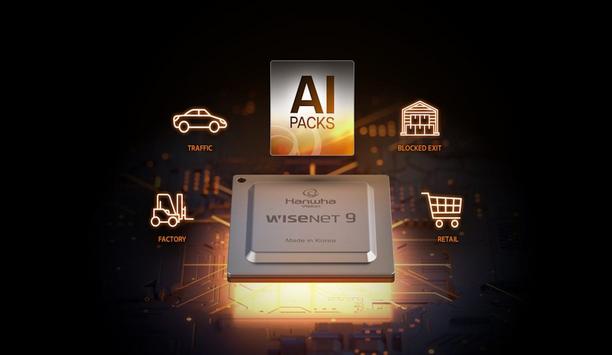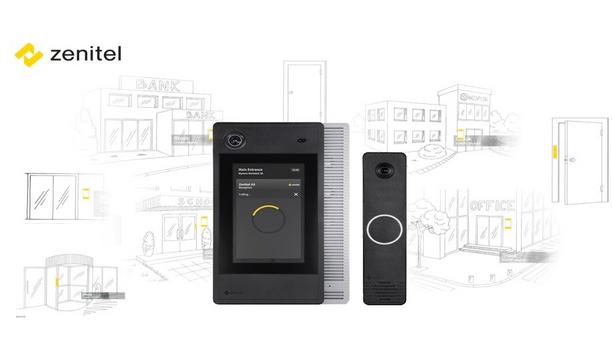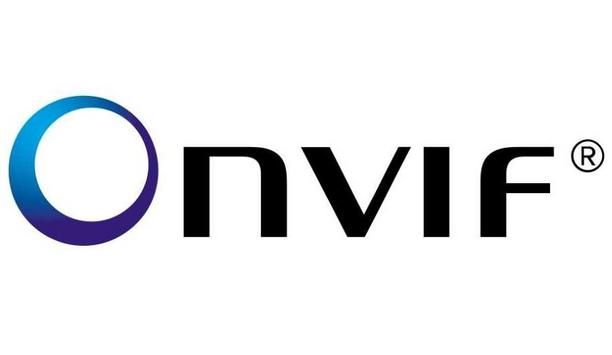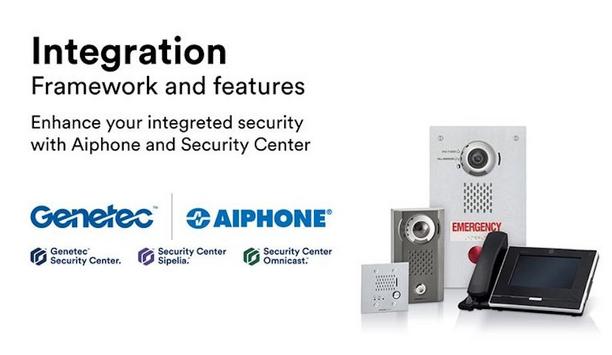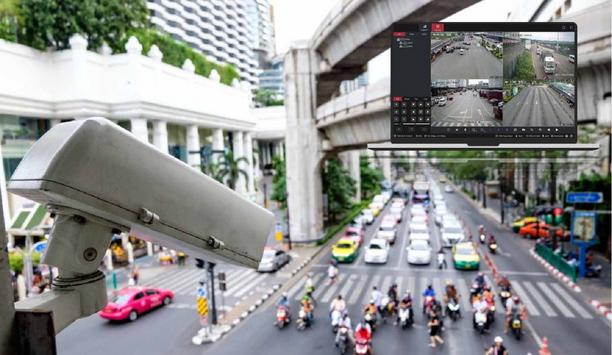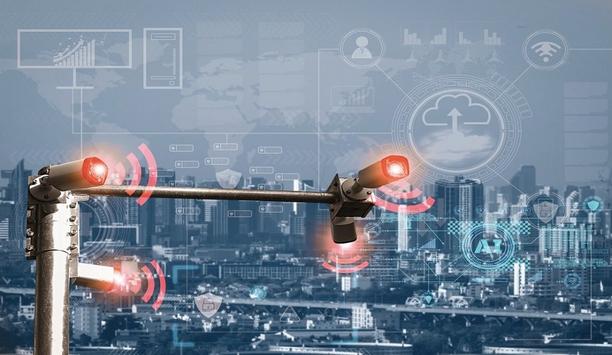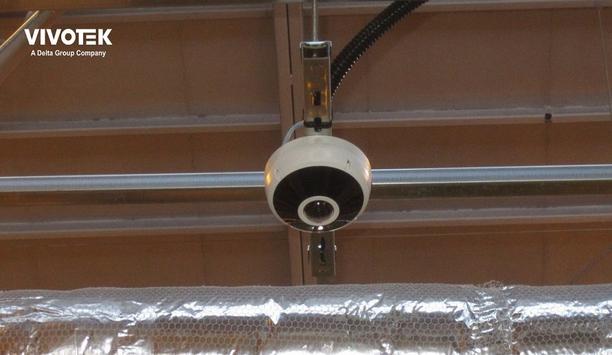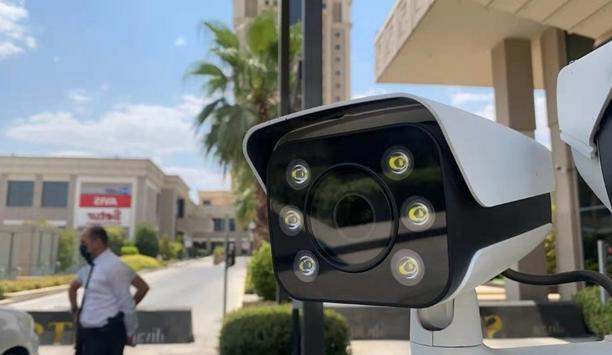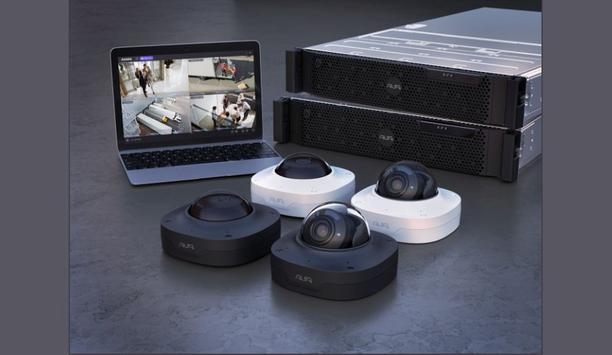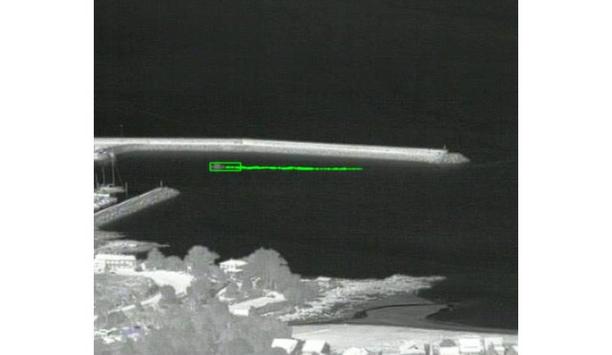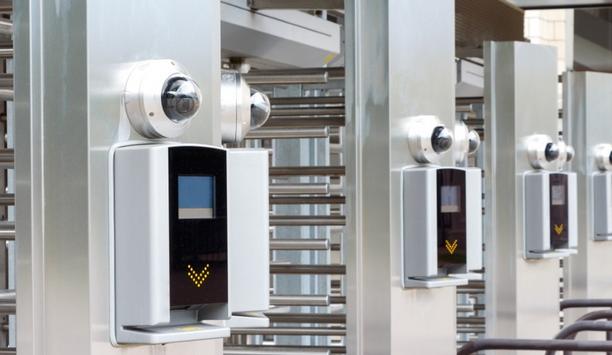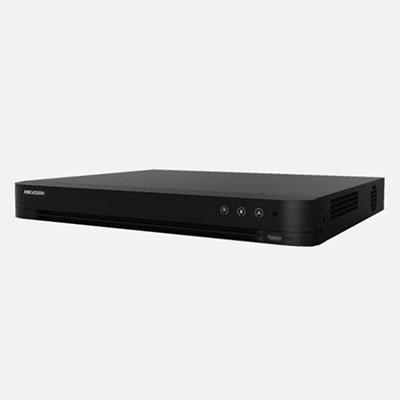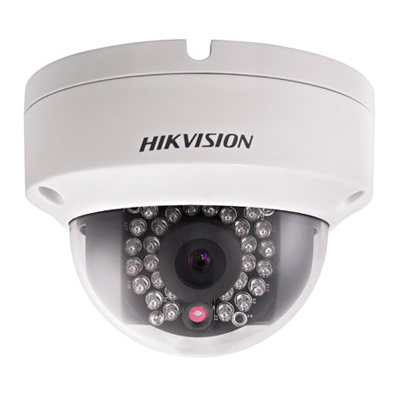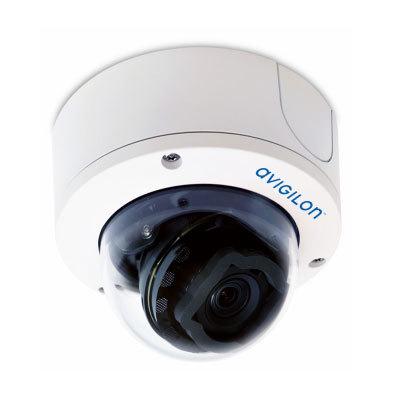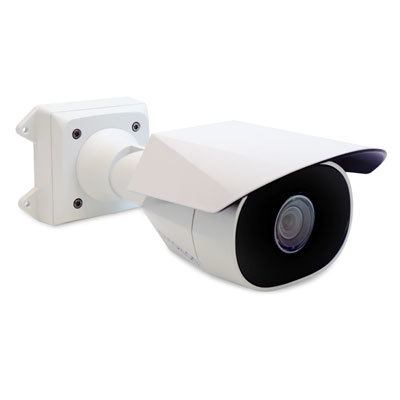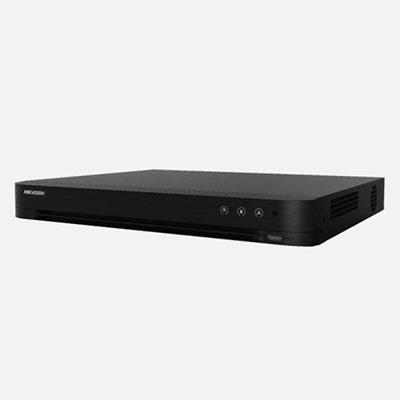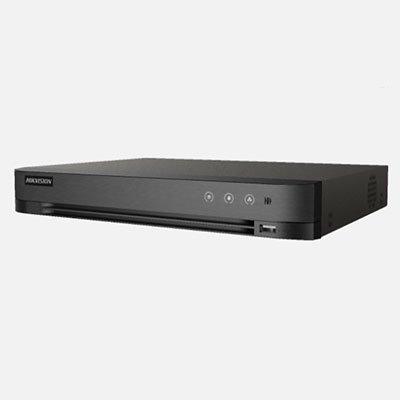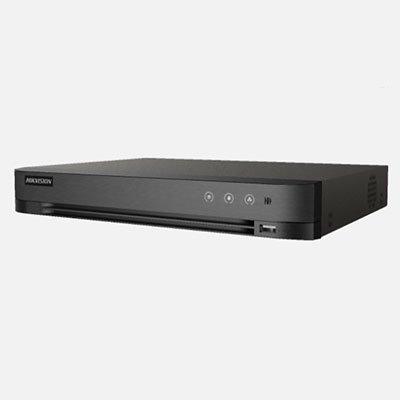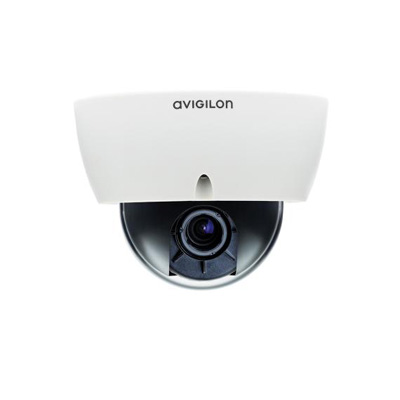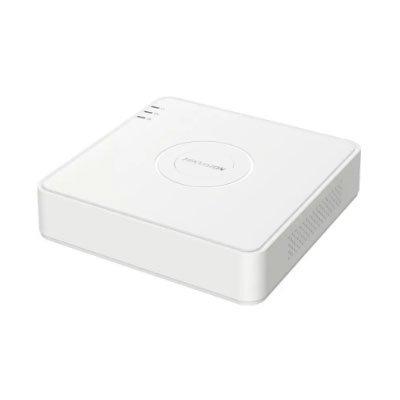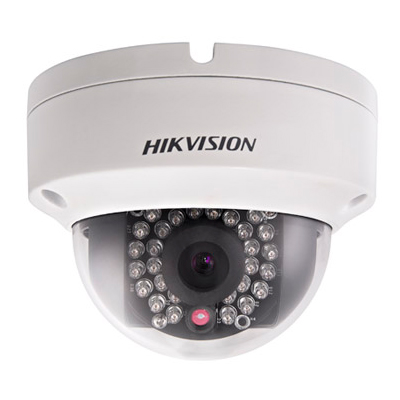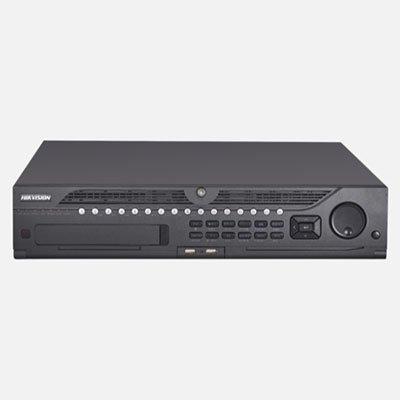ONVIF
The future of security requires smarter, more efficient and secure solutions, and Hanwha Vision is helping to drive this transformation with the launch of its most advanced AI-powered System on a Chip (SoC), Wisenet 9. After nearly four years of extensive research and testing, Wisenet 9’s advanced features help elevate our cameras into an AI-driven era, setting a new standard for performance, accuracy, and security. Unmatched clarity “With Wisenet 9, you can count on the superior...
Zenitel, a global pioneer in Unified Critical Communication solutions, is launching two new innovations for mixed-use building communication solutions: the Zenitel Display Door intercom (ZDD-1) and the Zenitel Slim Door intercom (ZSD-1). This launch further strengthens Zenitel’s position as a market leader in audio communication solutions. Amazing sound, effortlessly integrated New door entry intercoms are engineered from the ground up, offering a premium audio experience With 125 year...
ONVIF®, the pioneering standardisation initiative for IP-based physical security products, is returning to ISC West 2025 to highlight the critical themes of interoperability and the integrity of security video, two important issues facing the security and surveillance industry. In an educational session titled “Can Security Video Survive Generative AI?”, ONVIF Chairman Leo Levit will discuss the threats facing security video and how standards in this area can preserve trust in s...
Aiphone, the pioneer in security communication and access control solutions, announced the integration of the IX Series IP video intercom with Genetec™ Security Centre via Sipelia™ and Omnicast™. This collaboration enables organisations to harness the capabilities of an advanced IP video intercom system, fostering a more efficient, cohesive, and responsive security ecosystem. Challenges in security operations The integration addresses critical challenges in modern security o...
Verkada, a pioneer in cloud-based physical security, announced a wide range of updates to its Command platform that will make it even easier for its customers around the world to keep their people and places safe. To strengthen and enhance the entry experience, Verkada has deepened the integration of Verkada Guest and Verkada Access Control. Now, its customers can grant guests temporary, customisable visitor access credentials. Verkada's roll call reports Each credential is unique, time-bound...
IPConfigure, a trusted pioneer in enterprise video management software (VMS), has joined forces with Blue Eye, an innovator in remote video monitoring (RVM), to deliver an industry-first integration. This partnership empowers IPConfigure's customers to activate Blue Eye's advanced remote video monitoring services directly within the Orchid VMS platform, all in just a few clicks and without additional hardware requirements. Remote monitoring capabilities "This collaboration represents a transf...
News
Zenitel, a global pioneer in Unified Critical Communication solutions, proudly announces the launch of a new range of IP Speakers, further strengthening its market leadership position within safety and security communications. The addition of new IP Speakers, together with Zenitel Connect Pro — the industry's first Unified Critical Communication Platform — paves the way for unifying communication technologies to address life safety, security, and operational communication needs under a single platform. Built to deliver unparalleled sound quality, Zenitel’s new and innovative IP Speakers feature a high-efficiency power amplifier that delivers a high sound pressure level, making it an ideal choice for high noise environments, in addition to the ability to cover larger areas with fewer speakers. Bringing voices together with Zenitel’s IP speakers The new Zenitel IP speakers transform reactive security systems into proactive and interactive solutions Thanks to ONVIF and SIP compatibility, Zenitel’s new IP speakers simplify the integration into security systems, opening new possibilities for communication. Together with Zenitel Connect Pro, the new IP speaker range offers truly unified communication possibilities, enabling seamless communication among security personnel, control room operators, staff, and visitors. With a wide range of use cases, including public address, emergency notifications, security announcements, and background music, the new Zenitel IP speakers transform reactive security systems into proactive and interactive solutions. At the forefront of technology With up to 123dB SPL output, Zenitel’s new IP speaker range delivers excellent sound clarity for public address broadcasts, even in extremely noisy environments. With the ability to individually addressed, they provide cost-effective PA solutions for medium and small projects without losing zone granularity. The innovative power supply design, featuring dynamic power management, delivers a full 30W output for voice applications even with standard PoE, eliminating the need for a PoE+ switch. Eco-design principles Zenitel’s IP speakers are optimised to quite lower idle power consumption and lower energy costs In line with eco-design principles, Zenitel’s IP speakers are optimised to significantly reduce idle power consumption, helping lower energy costs. Equipped with integrated speaker-as-a-microphone technology, the IP speakers become an essential part of a unified critical communication solution, enabling seamless one-way and bi-directional communication without requiring additional equipment. Trusted communication, protected by design Zenitel is committed to ensuring the highest level of cybersecurity across all its technology offerings. Cybersecurity requirements are fundamental to any security specification. Zenitel provides guidance, advanced technologies, and tools that support the industry's best practices. Zenitel’s latest IP speakers are no exception. Hardware Root of Trust on IP speakers provides a trusted foundation for verifying the integrity of hardware components, software, and data. Secure boot assures that the boot software is approved by Zenitel. Verified image upload assures that the software that is uploaded on the device comes with Zenitel approval. Introduction of Zenitel Connect Pro “Last year, with the introduction of Zenitel Connect Pro, we laid a robust foundation for the future of unified critical communication (UCC) offerings. At the beginning of this new year, we are happy to share the launch of a new IP speaker range, further strengthening our UCC offerings,” says Lars Paulsson, EVP for Safety and Security at Zenitel. “The launch of our new IP speaker range marks a significant step in expanding our UCC offerings. As the demand for audio communication solutions grows, we believe these IP speakers will redefine Security, Safety and Operational communication,” Paulsson adds. With the new IP speaker range, Zenitel reaffirms its commitment to setting industry benchmarks in critical communication, ensuring safety and seamless communication across every environment.
Moxa is extending the advantages of IP video surveillance to challenging transit applications with the debut of its new VPort 07-3, an EN 50155-compliant onboard dome camera. An ideal surveillance solution Hardened against service interruptions caused by heavy vibration, impact, or water ingress, the new camera is an ideal surveillance solution for light rail, buses, and passenger rail fleets. Built around a 3MP progressive-scan CMOS sensor, it captures sharp 2048 x 1536 pixel images at up to 20 frames-per-second, leveraging bandwidth-efficient H.265/H.264 and MJPEG compression to support multiple independent streams, while benefitting from Moxa's innovative DynaStream™ and CBR Pro™ network technologies. Around-the-clock surveillance VPort 07-3 easily manages scenarios where there are significant variations in light intensity As trains enter and exit passenger stations, underpasses, and tunnels, lighting can abruptly fluctuate from dark to light. Adding to these challenges, most rolling stock is in continuous operation both day and night. Regardless of lighting conditions, the VPort 07-3 assures forensic-quality imaging by adopting a powerful combination of Dynamic Noise Reduction (DNR), Wide Dynamic Range (WDR), and an advanced Auto White Balance (AWB) algorithm that resolves lighting challenges and reduces motion blur. Due to its 100dB WDR, the VPort 07-3 easily manages scenarios where there are significant variations in light intensity within the same frame, ensuring the smallest of details are visible in both bright and dark areas. Flexible design options Designs of trains and buses can vary greatly, and all surveillance projects have distinct specifications that need to be met. Versatile Moxa VPost 07-3 cameras are available in a variety of models featuring fixed-focal-length lenses from 2.4mm to 8.0mm, line-in or microphone audio interfaces, and different temperature ranges to help create custom solutions to fit the requirements of any project deployment. For maximum efficiency and minimal wiring costs, all models support PoE (802.3af) and 24VDC power inputs. ONVIF conformity assures interoperability with third-party devices and software. Industrial-grade cameras Moxa VPort 07-3 cameras are compliant with mandatory sections of the EN 50155 Railway Certification and the EN 62262 IK8 vandal-resistant rating. To meet these standards, the cameras have been rigorously tested and approved for rolling stock installation and railway deployments. This includes being certified to withstand temperature ranges from -40° to 70°C, damaging EMI/surges, vibration, and other environmental pressures common on rolling stock. Advantages Moxa VPort 07-3 cameras feature an IP-66-rated metal housing, a PC dome cover with a built-in heater Moxa VPort 07-3 cameras also feature an IP-66 rated metal housing, a PC dome cover with built-in heater and demister, plus a weatherproof M12 Ethernet port providing reliable connectivity where a standard RJ45 connector would fail. In addition, there is 8GB of onboard storage to ensure continuous video recording even if recorder connectivity is lost due to a power outage. All these advantages make the cameras an outstanding choice for mission-critical mobile surveillance. Bandwidth preservation Because preserving network bandwidth is a pivotal issue in IP deployments, Moxa VPort 07-3 cameras incorporate the company's patented DynaStream™ function, which automatically changes the video frame rate to control network bandwidth budget and ease system management. Another function, Moxa's CBR Pro™, guarantees no packet loss in limited bandwidth transmissions, ensuring that images will not exhibit the mosaic effect. Advanced network security functions prevent unauthorised access or data hijacking of surveillance video.
Dallmeier Electronic, one of the pioneering providers of professional video surveillance solutions, is expanding its product portfolio with the Picoline. With the entry-level camera, Dallmeier offers a compact and cost-effective solution for applications that require day and night recording with the highest resolution (IR mode). Whether for use in an environment with difficult lighting conditions or where space is limited, the Picoline delivers high-quality results. Range of cybersecurity features The small form factor enables installation in confined spaces on ceilings or walls and is via PoE The Picoline combines high image quality with up to five MP resolution, a wide range of cybersecurity features and AI analytics in a compact surface mount housing. The small form factor enables installation in confined spaces on ceilings or walls and is powered via PoE. As an all-rounder, the entry-level camera is designed for a wide range of applications. Domera® OS–cybersecurity “made in Germany” Security is a top priority for the Picoline series. Thanks to the closed Linux operating system Domera® OS, users benefit from extensive security functions. Regular external penetration tests, monitoring and maintenance ensure that the software components are always up to date with the latest security standards. Security updates throughout the entire life cycle “Made in Germany” is a reality for Dallmeier customers. In addition to functional updates for at least five years with the option to extend, Dallmeier provides security updates for relevant CVE vulnerabilities that have become known (subject to technical feasibility) for the entire duration of the software maintenance. Efficient surveillance with AI EdgeAnalytics With the optional “Basic AI Object Classification”, the Picoline can detect and classify objects such as people or vehicles – regardless of movements in the background. AI EdgeAnalytics applications, such as “Loitering Detection”, “Intrusion Detection” and “People Counting”, allow users to analyse and evaluate the events that are relevant to them. Analysis via any ONVIF-compliant VMS and control of IoT devices The camera series is ONVIF compatible, so users can easily integrate it with Dallmeier client software and other ONVIF-compatible VMS systems. Event messages can be sent by email or used to control IoT devices via MQTT and HTTPS. High image quality even in challenging lighting conditions Each frame is captured with two special settings that are combined in real-time to produce a balanced result The cameras are equipped with a High Dynamic Range (HDR) function to optimise the capture of high-contrast scenes with very bright and very dark areas. Each frame is captured with two special settings that are combined in real-time to produce a balanced result. The resulting video stream offers significantly more detail in both light and dark areas and is optically very similar to how the human eye perceives them. Optional edge recording Want to record two video streams with different settings at the same time? This is possible with EdgeRecording on an integrated SD card of up to 1TB. Triggered by an EdgeAnalytics event, recording allows critical moments to be captured with adjustable lead and lag times. In addition, the video stream can be transferred to a recording system for permanent backup. The Picoline series offers users a flexible, cost-effective and secure solution for a wide range of surveillance requirements. Like all Dallmeier cameras, the Picoline delivers recordings with excellent contrast, brilliant clarity as well as maximum detail resolution and colour fidelity.
ONVIF®, the renowned global standardisation initiative for IP-based physical security products, has released the first course in a new online learning initiative designed to promote greater knowledge and understanding of the workings of ONVIF. The new 'Introduction to ONVIF' course offers a comprehensive overview of how the organisation and its standardised interfaces work for the interoperability of IP-based physical security products and services. Benefits of ONVIF standards The e-learning course is free of charge and is available to anyone interested in learning more about ONVIF Available on the ONVIF website, the interactive course educates users on the ONVIF mission and organisation, the benefits of ONVIF standards, what ONVIF profiles and add-ons are and practical applications for both, and the importance of the conformance process. The e-learning course is free of charge and is available to anyone interested in learning more about ONVIF. “With today’s rapidly advancing technology advancements, education and knowledge sharing is increasingly important for organisations of all types to achieve their business goals,” said Leo Levit, Chairman, ONVIF Steering Committee. Understanding of ONVIF Leo Levit added: “This e-learning course will help increase the understanding of ONVIF and the advantages of incorporating ONVIF conformant products into a security system.” ONVIF member companies can also access the e-learning course for use on their internal learning management platforms to provide this information to their staff and customer base. IP-based physical security products ONVIF is an industry forum driving interoperability for IP-based physical security products Founded in 2008, ONVIF is a pioneering and well-recognised industry forum driving interoperability for IP-based physical security products. The organisation has a global member base of established camera, video management system and access control companies and more than 30,000 profile conformant products. ONVIF offers Profile S for streaming video; Profile G for video recording and storage; Profile C for physical access control; Profile A for broader access control configuration; Profile T for advanced video streaming; Profile M for metadata and events for analytics applications and Profile D for access control peripherals. IP interoperability solutions ONVIF continues to work with its members to expand the number of IP interoperability solutions ONVIF conformant products can provide. Further information about ONVIF conformant products, including member companies and their conformant models, is available on the ONVIF website.
VIVOTEK (3454-TW), the pioneering global security solution provider, through its AI-powered operations automation platform VORTEX, continues to expand its cloud technology efforts, achieving a high level of AIoT integration with hybrid cloud solutions that ensure data security and broad hardware integration capabilities. Earlier this year, VORTEX launched its VORTEX Connect feature, allowing users to remotely update firmware, monitor system health, and troubleshoot issues without the need to replace existing network cameras. This is done by connecting to VIVOTEK's Core+ AI Network Video Recorder (NVR). This quick response to customer needs ensures uninterrupted security and, since its release in January, has been well-received, driving the number of cloud-connected devices for small and medium-sized businesses to grow exponentially every month. Cloud management capabilities VORTEX has enhanced its cloud management capabilities for existing cameras To meet the diverse security needs of its users, VORTEX has enhanced its cloud management capabilities for existing cameras. From now on, users can benefit from unlimited device connections and user accounts with their subscription. The platform also supports third-party system integration. Additionally, VORTEX supports Single Sign-On (SSO) and Multi-Factor Authentication (MFA), making it ideal for multinational corporations, chain stores and large campuses, enabling them to access video footage anytime and anywhere, improving operational efficiency and ease of use while maintaining data security. VORTEX meets market expectations According to a market research report, the cloud security market is expected to reach USD 3.13 billion in 2024 and grow to USD 7.76 billion by 2029, with a CAGR of 19.91% from 2024 to 2029. In light of this trend, VORTEX is dedicated to offering flexible hybrid cloud solutions, including both VORTEX cameras that connect directly to the cloud and devices that connect through VIVOTEK's Core+ AI NVR, maximising cost-effectiveness and security performance. Multi-location security needs with third-party system Additionally, the VORTEX hybrid cloud solution supports integration with third-party systems For users with large-scale remote security deployments, VORTEX offers account and camera management permissions, with cloud storage for video evidence, significantly enhancing overall security. Additionally, the VORTEX hybrid cloud solution supports integration with third-party systems, such as access control and identity verification, enabling users to monitor triggered events or login statuses simultaneously. This allows users to manage all information from a single platform, receive real-time alerts, and streamline cross-system operations and data comparison, improving the efficiency of critical incident management and enhancing site security. Security deployment requirements VORTEX, in conjunction with VIVOTEK’s Core+ AI NVR and VORTEX cameras, creates a hybrid cloud solution. Through VIVOTEK’s Core+ AI NVR, including models ND9326P, ND9426P, ND9442P, and ND9542P, users can bridge more than 30,000 ONVIF Profile S network cameras available on the market. This allows users to integrate cloud management without replacing their cameras, while also providing remote video management. Users can also scale cloud cameras flexibly to meet their security deployment needs.
The new IDIS Lite Series, including ruggedised IP67 and IK10-rated NDAA-compliant cameras—turrets, domes, and bullets—is a cost-effective video surveillance option for small to mid-size applications. The IDIS Lite Series includes a range of 2MP and 5MP cameras equipped with lenses that enable clear identification right from the centre to the edge of every scene. Value surveillance solution IDIS is offering the new range as a value surveillance solution that benefits systems integrators These affordable yet high-performance cameras have a 3-axis design for easy pan, tilt, and horizontal adjustment and come with a practical choice of brackets and mounts. They offer rapid click-and-play setup, ensuring hassle-free installation and extended ONVIF compatibility. IDIS, Korea’s largest in-country video tech manufacturer, is offering the new range as a value surveillance solution that benefits systems integrators and end users with assured performance, effortless operation and lower operating costs. IDIS recording solutions The new line-up offers the benefits of an optimised, user-friendly interface and seamless compatibility with IDIS recording solutions, ensuring that surveillance systems are scalable, flexible, and future-proofed. IDIS Lite Series allows users to connect seamlessly with IDIS’s broad range of 4 to 64-channel NVRs. The dome, turret, and bullet models have IP66/67 ratings, support SD card recording and playback, robust aluminium casings, and vandal-proof glass, giving them exceptional durability to ensure reliable HD image capture even in harsh environments. Sony Starvis CMOS image sensors IDIS resolved the exposure cases caused by uneven lighting, with optimised image contrast The IDIS Lite cameras use Sony Starvis CMOS image sensors to ensure crisp, high-definition monitoring and recording 24/7. To ensure outstanding image capture in darkness, IR illumination is automatically focused to ensure that the field of view is consistently lit, providing up to 30 metres of nighttime vision. With True WDR and an automatic iris, IDIS has resolved the exposure issues caused by uneven lighting, with optimised image contrast revealing previously hidden details. Standout models include the dome cameras, which feature a patented IDIS design that eliminates IR reflection without bubbles, and the 5MP IR turret cameras that boast a flat face with fixed and varifocal lens options (DC-D2511WER and DC-D2531WER), enabling superior day and night image quality. IDIS Lite Series “For customers who need to watch over smaller and mid-size locations and for security, facilities and loss prevention managers working in price-sensitive markets, the IDIS Lite Series offers exceptional value, high-performance monitoring and stable recording, with both outstanding ease of installation and ease of use,” says Alex Lee, IDIS MEA & Asia Senior Sales Manager. “And like all IDIS end-to-end solutions, our IDIS Lite Series come with the assurance of South Korean manufacturing, local technical support, and assured forward and backward product compatibility, giving customers the peace of mind of an industry-best low total cost of ownership.”


Expert commentary
Enable third-party application system quickly to incorporate the visual data, as part of their solutions. Each and every user has a unique set of platforms that they need to efficiently run their business. In the security and surveillance field, increasing interest in visual sensor networks drives the development of multi-camera applications in private and public areas. Thus, middleware is needed to facilitate video data sharing connections between software platforms. It works like video plumbing, as it connects two ends of software platforms together so video data and databases can be easily passed between the ‘pipe’ for various applications. How does a middleware for video surveillance work? Video retrieval The middleware should work as software platform to receive and collect video from multi-cameras First, the middleware should work as software platform to receive and collect video from multi-cameras. Thus, those features are required for the middleware to work with video that can help user easily add various video sources into the application. The middleware platform should support many protocols, such as ONVIF, GB/T28181, GA/T1400 etc. The more protocols it supports, the more cameras it can access. Set ONVIF protocol for example. Nearly 80% famous overseas video surveillance manufacturers in the world all support the standard protocol ONVIF, if the middleware system supports ONVIF, which means it can communicate with above 80% cameras and receive the video from them with no problem. And, also the middleware platform can be set up to work with an RTSP,HLS,HTTP-FLV, WebSocket video source with an URL – for example, a synthetic video source, like VLC stream server, which make the integration process simple and easy. Video management Second, after collecting the video, middleware should allow the integrating application to manage video archives from multi-cameras in geographically distributed locations, and realise video management functions, such as video monitoring, local or network or cloud-based storage options, intuitive E-map display, gathering information on remote objects alarms, quick and convenient search and playback etc. After realising video management performance, the middleware becomes video management middleware. And, it should contain a ready video management mechanism available via REST API, while integrating application defines management policy. Easily integrate with third-party application The video management middleware is better to designed as an SDK Third, the middleware should easily integrate with third-party application, so that video data sharing connections between software platforms can be put through, and the third-party application can easily incorporate video, as part of their own video solution. In order to realise this, the video management middleware is better to designed as an SDK. That is every piece of functionality implemented in middleware is available via programming interface, and the functionality is said to be implemented. Standard video data for third-party industry platforms And what’s more, standardised media stream formats, such as HTML5 are better to provide for the convenient interaction with third-party applications, particularly in media interchange. So that it will be easily to push the standard video data to many third-party industry application platforms, and make video playback possible on most of popular browsers, and mobile devices. When you are giving those information to a third party application system, it will be able to acquire the video data and sync information to perform other task via middleware. What are benefits the video management middleware brings? Enable third party application system quickly to incorporate the visual data as part of their solutions. As the easy integration features the video management middleware brings, the third parties don’t need to put more energy on aggregating video sources from multi-cameras and waste more cost on developing. All they need is to enjoy the visual data via convenience and quick integration from the video management middleware, and then focus more energy on application-level development, while saving developing costs. Easy deployment and saving cost With the progress of the security technology, some old security infrastructures need to be upgraded as well, such as community security project, school security projects. If replacing all the front-end cameras, it will cost a lot. The most economical and efficient way is to add new functional cameras at most important monitoring spot, while still keep some old cameras. Thus, the video management middleware is needed. Users only need to install middleware software on the computer. By the video management middleware, users can collect and manage the video resources from various brands front-end video device without replacing the original monitoring equipment and deployment, thus making full use of old devices and greatly reduce the cost of video integration and application.
Nowadays to save costs by making full use of old devices while upgrading the old security projects, many integrators or installers prefer to use video management software to manage multiple brands of video devices (such as IP cameras, and NVR), instead of only one single brand. So that they could have more flexible choices to earn profits while saving costs. Multi-brands video device management On other hand, with market segmentation and specialisation, instead of managing the video by themselves, application service providers of different industries prefer video surveillance companies could help them to collect the video from various brands of front-end video devices. Thus they could focus more on application development according to the characteristic of different industries. Therefore to meet the requirements of the surveillance market, how to manage multi-brand video devices has become very important, especially for third-party video management software companies. Then how to manage multi-brands multi-brands video devices (such as IP cameras, and NVR) with your VMS system? The first step is: integration Preparing your system for video devices integration Selecting an open architecture VMS system allows for a deeper, seamless level of integration There’s more to integration than just the ability to plug in a video device. Does your VMS allow you to take advantage of the latest IP camera and other video device technologies? Does it support open architecture? Closed architecture systems offer limited integration. Selecting an open architecture VMS system allows for a deeper, seamless level of integration, and allows you to upgrade hardware at your own pace. It also allows you to expand your suite of security solutions in the future, as your needs change. Choosing a VMS system And these questions also need to be considered when choosing a suitable VMS system: Does your system support multiple protocols to communicate with video devices? Can your system easily integrate the private SDK provided by the IP camera manufacturer? Make sure the communication between multi-brand video devices (such as IP cameras, NVR) and your video surveillance VMS system can be put through. ONVIF Nowadays most famous overseas video surveillance manufacturers all support the standard protocol ONVIF, which enable VMS system easily to access their video devices (such as IP cameras, and NVR). Some will provide protocols like RTSP, HLS, HTTP-FLV, and Websocket. Some will provide their private protocols like EHOME/ISUP protocol and DHOME. And also GB/T28181, and GA/T1400 protocols are very popular in China. Simple and easy integration As for the VMS system, the more protocols it supports, the easier it can put through communication As for the VMS system, the more protocols it supports, the easier it can put through communication with the front-end video devices. Thus it will make the whole process of integration simple and easy. And about video surveillance manufacturers who only can provide SDK, in this way open architecture of VMS system is needed because it can help to put through the communication smoothly. The second step is management Since communication between front-end video devices and the VMS system is put through. VMS system can access, capture, and collect the video from the network video devices (both live and recorded). It then stores that video to dedicated data storage media (on-premises, external locations, or in the cloud), based on automated policies, pre-determined by the organisation. That is how a VMS system work. But if the front-end devices are different, they are using a different format, bitrate, and resolution. For example, one brand of IP camera uses H.265, 4K resolution, and the other brand of IP camera use H.264, 1080P. How can a VMS system manage them together? Video transcoding technology That requires the VMS system should have efficient video transcoding technology to convert different video formats and resolutions into unified video formats and resolutions, and strong video transmission technology to meet low bandwidth network adaptability. Smooth streaming automatically adjusts bit-rate and resolution between the VMS system and front-end devices according to real-time network conditions. For example: The video with a high bitstream can be converted to a low bitstream. 8K,4K,3M, 10 80P. .. → D1,CIF,VGA... Transcode video in different encoding formats to the unified encoding formats. H.265, MPEG4 → H.264 The third step: output standard video data for the third-party integration A good VMS system should provide convenient ways for several video processing applications. In interactions applications, particularly in media interchange, a good system should output standardised protocols and stream formats (such as HLS, RTSP, WebSocket, etc) according to the needs of the third party, so that the third party can easily acquire and use video from VMS system for the further application or development.
Perimeter security is by no means a new concept. A phrase used to describe solutions with the primary purpose of limiting access to any area that is prohibited to the public at large, perimeter security has been prevalent for millennia. From Hadrian’s Wall that was built by the Roman Empire in Britain back in AD 122 to the Great Wall of China that winds almost 22,000 kilometers through the Asian country’s eastern regions, it is a concept that remains a fundamental part of global societies today. Fast forward to today and no longer are we reliant on 50-foot-high, 20-foot-thick stone blockades to protect our safety. Perimeter security has evolved over the centuries moving from empires and structures to products and cutting-edge technology and continues to grow today. In fact, in 2020 Perimeter Security was a $61.3 billion industry as more businesses and industries have the need to protect against modern-day threats. This colossal and growing market is powered by industry innovators that are providing advanced solutions that are reliable, integrated, and cost-effective. Layered Perimeter Security Defense The number of perimeter intrusions is a large reason behind the continued surge in security investment, propelled by increasing urbanisation, a growing terror threat, and a plethora of other concerning factors. Most organisations are better equipped to protect people and assets today, yet there is still a need for solutions that can grow with our future needs and the unforeseen challenges ahead. For many, this means moving beyond siloed solutions into a multi-layered, integrated physical security strategy – one that provides the best security posture possible. There are a variety of innovative technologies that can create a holistic perimeter security solution that will transform the defences of any organisation. The question is, what are the technologies and trends shaping perimeter security in 2021 and beyond? Next-Generation Video Surveillance By combining two powerful visualisation technologies in a single form factor, rich data can be captured and deliver more accurate awareness In today’s surveillance market, cameras and video management systems are nothing like those that were available a mere half-decade ago. Cameras now readily feature ultra-HD and 4K resolution that provide an extremely high level of detail, enhancing security teams’ ability to capture evidence and identify perpetrators. This enhanced detail bolsters not only investigation sequences but equally transforms video analytics capabilities, like facial recognition that unlock additional business benefits. Where are cameras heading in the future? Let’s look at Oyla’s cameras as an example. These cameras fuse together artificial intelligence (AI), video, and 3D data, offering a depth camera that can be used to define very accurate intrusion detection perimeters. Its advanced motion detection activates an alert when a user-defined perimeter has been crossed, or if there is a presence in a user-defined area or volume space. By combining two powerful visualisation technologies in a single form factor, rich data can be captured and deliver more accurate awareness and better application of deterrence measures in real-time, versus the evidentiary use of cameras today. Thermal Cameras Thermal cameras are a relatively novel yet growing security phenomenon, having come to the forefront during the pandemic. Where such technology was once a novelty, their widespread application in detecting raised temperatures which might indicate a COVID-19-related fever has seen them become increasingly applied to a broader market in the past 18 months. Not only are these cameras now more accessible, but they have also advanced from a technical perspective. Modern thermal cameras now offer a more accurate thermal resolution, longer detection ranges, ONVIF compliance and edge-based analytics for the benefit of VMS solutions. They are also a useful technology for solving visibility challenges in complete darkness. Radar Radar is a technology that’s increasingly being used in physical perimeter security applications. Capable of conducting 360-degree scans of a property on a continual basis every couple of seconds, it is an extremely powerful intrusion detection technology. Radars stand up better than other technologies in difficult conditions such as smoke and fog. When paired with other sensors, false alarms can also be reduced in these conditions – something that is a major challenge more broadly. While law enforcement responds to millions of security alarms every year, a study from the United States Department of Justice's Office of Community Oriented Policing Services previously showed that between 94 and 98 percent of these turn out to be false, costing as much as $1.8 billion a year in wasted police time and resources. LiDAR What is LiDAR? LiDAR has been around since the 1960s, with one of LiDAR’s first use cases was being attached to aircraft to emit laser light towards the surface of the earth to provide distance readings. Spurred by its necessity for the coming autonomous driving revolution, today, the application of LiDAR technology has become more widespread. It is technologies such as these, designed to reduce the burden of security personnel by conducting the heavy lifting in alarm validation According to research by Fortune Business Insights, the size of the global LiDAR market is set to surpass $6.7 billion by 2026, a monumental increase on the $1.32 billion spent on LiDAR in 2018. In the security space, LiDAR technology is already proving it carries a string of benefits and upgrades on what is currently available on the video surveillance market. The major upside of LiDAR is that like video, it brings a high level of detail to a physical environment that other sensors simply cannot provide. Pairing Lidar with video, machine learning, AI, and other advanced sensor technologies can help validate alarm accuracy. Indeed, it is technologies such as these, designed to reduce the burden of security personnel by conducting the heavy lifting in alarm validation, that we can expect to become increasingly prevalent soon. Drones Often referred to as unmanned aerial vehicles (UAVs), drones are another technology that is becoming both more accessible and more capable from a security perspective. In sizable areas of land or hard-to-reach critical infrastructure sites, drones can be dispatched instead of security personnel as a means of first response to an intrusion alert. They can also work in tandem with thermal imaging, radar, lidar, and next-generation video surveillance technologies, either incorporating them onboard directly or supporting them in wider, integrated security infrastructures. Developing the Right Multi-Layered Perimeter Security Strategy These are just a handful of some of the more progressive perimeter security-centric technologies on the market today. The challenge for many organisations is knowing which solutions will suit their needs and address the challenges of tomorrow. Take the time to understand what you need to protect. Is it people, data, or assets? Where do you feel your potential vulnerabilities may lie? By assessing your risks, you will better understand potential target areas and address them accordingly. For perimeter security, a multi-layered solution will likely be the most secure approach. From basic needs to the more advanced, there are a broad variety of possible solutions available. Yet taking the time to understand which solutions are the most successful, cost-effective, and relevant to your business will yield the best results.
Security beat
The Physical Security Interoperability Alliance (PSIA) was founded in 2008 with a goal of creating ‘plug-and-play interoperability’ among physical security devices, systems and services. Since then, the organisation’s mission has both expanded to include logical security and focused more narrowly on identity, a critical aspect of security today. In recent years, PSIA has concentrated on its PLAI (Physical Logical Access Interoperability) specification, which provides a means to enable disparate physical access control systems (PACS) to communicate to each other and share employee identity data. This is especially important for companies who have made acquisitions and inherited different incompatible PACS systems. “PLAI can unify a security environment through one trusted source, even if there are multiple PACS systems,” says David Bunzel, Executive Director of the Physical Security Interoperability Alliance (PSIA). Bridge between disparate PACS The PLAI specification provides a bridge between disparate PACS, allowing a single trusted source for identity management. Leading PACS vendors including JCI (Software House), Lenel, and Kastle Systems and biometric vendors including Eyelock, Idemia, and Princeton Identity, have each implemented PLAI adapters, supporting this specification. AMAG will have their adapter in the coming months, and Honeywell and Siemens have it on their road maps. At ISC West last April, PSIA was able to demonstrate five of these vendors sharing records and the ability to add and terminate an employee and have it updated across each PACS and biometric system. PSIA was able to demonstrate five of these vendors sharing records at ISC West last April The Physical Security Interoperability Alliance (PSIA) has evolved from supporting physical security to also integrating logical security. Access to facilities and secure areas of buildings is increasingly dependent on software and hardware systems which can validate a person’s identity. “The PSIA has chosen to focus on interoperability between identity management systems and access control devices,” says Bunzel. “We have successfully demonstrated the technology, and it is now being specified by consultants, integrators and enterprise customers in actual security systems. We expect to see some large companies announcing PLAI implementations in the next quarter.” Open standards processes PSIA relies on an open standards process, with collaboration among leaders in the various parts of the security industry. Specifications are architected, discussed, drafted, and reviewed by members of the organisation in technical committees. The process is dynamic, with periodic updates added, which will improve and enhance the specifications as appropriate. The PSIA has focused on identity management for enterprise customers, says Bunzel. “We have active members who make devices that support access hardware (for example, locks and biometric systems) who by design complement PACS vendors and HR management systems.” PLAI also enables a variety of services for enterprise customers that may rely on a security credential" “We continue to add more PACS and biometrics vendors to the PLAI ecosystem, expanding the value of the specification in the market,” says Bunzel. “PLAI also enables a variety of services for enterprise customers that may rely on a security credential, including printing services, parking, and facility management. In the near future, the PSIA expects to extend PLAI into elevators. There are other identity management capabilities, and the PSIA will evaluate opportunities as the market demands them,” says Bunzel. In addition to PLAI, PSIA has several ‘legacy’ specs, but they are not actively working on further iterations. PSIA could always consider new development on legacy specs if the market demanded it. Some legacy specs address video, and security cameras often work with access control systems. However, PSIA currently is leaving video to ONVIF. The near-term direction and plan for the PSIA is to focus on PLAI and its commercialisation.
Whether it is video analytic platforms to monitor traffic patterns or cameras deployed to help law enforcement ensure public safety, many cities are looking at advancements in video technology. Upgrade costs and technology compatibility issues are often front-and-centre when it comes to blending new technology with existing infrastructure. For example, if the city law enforcement officials want to improve video camera image quality, which can improve the evidentiary value of footage in prosecutions, they may look at newer HD or IP-based video systems. Upgrading to a hybrid DVR system Applications include perimeter monitoring, public parking, city transportation, square/town safety To stretch a tight budget, a migration plan to an IP-based camera system could be phased in over time by centering the upgrade on a new hybrid DVR system. This way, both existing analogue and newer IP-based cameras can be hooked into the system. For example, Hikvision’s Smart City Solutions include systems for government services, transportation and traffic management, or any combinations of these. Applications include perimeter monitoring, public parking, city transportation, square/town safety and temporary surveillance. Data capture form to appear here! Heart of City strategy Dahua Technology, a video-centric smart IoT solution and service provider, has introduced its ‘Heart of City (HOC)’ strategy, which is in line with the top-level design experience from hundreds of city projects. The strategy is based on the maturity of five technologies – artificial intelligence (AI), big data, cloud computing, IoT and 5G. The combination will enable the evolution of smart city 3.0 and bring great changes to our life, according to Dahua. A 300-plus camera city centre video surveillance scheme in the UK city of Lincoln has been installed and commissioned using Dahua's cameras, monitors and switching equipment A 300-plus camera city centre video surveillance scheme in the UK city of Lincoln has been installed and commissioned using cameras, monitors and switching equipment from Dahua Technology. The design of the new all-wireless encrypted system was based around delivering flexible technology, reducing the total cost of ownership, ease of installation, lower maintenance requirements, smart edge analytics and remote connectivity. Future-proof radio network design Environmentally friendly aspects of the project included specifying lower-energy equipment, integrating remote support and recycling hardware wherever possible. The installation of the new IP full HD system and network is part of Lincoln’s smart city strategy – Vision 2020 – which seeks to harness new technologies to improve the lives of citizens. One of the results is the provision of free Wi-Fi in the city, working alongside the Dahua cameras using the same IP wireless network. Wearables are another new aspect of city surveillance system. For example, FLIR Systems, Inc. has announced FLIR TruWITNESS, a wearable sensor platform designed for city-level security and public safety operations. TruWITNESS combines video, audio, location data, Internet of Things (IoT) capabilities, and cloud and management software in one solution, allowing organisations to reach a new level of situational awareness. TruWITNESS is worn on an individual’s body or mounted inside vehicles and is designed for any public safety organisation that requires on-scene, real-time mobile surveillance TruWITNESS is designed for any public safety organisation that requires on-scene, real-time mobile surveillance. Worn on an individual’s body or mounted inside vehicles, TruWITNESS includes visible-video, audio, global navigation satellite system (GNSS), gyroscope, accelerometer and magnetometer sensors. These sensors combine to send alerts and stream data to a central command centre in real-time to ensure full situational awareness and global event handling. Featuring FLIR Neighbor Aware inter-device connectivity, TruWITNESS acts as an IoT device, triggering nearby TruWITNESS devices, fixed and motorised Pan-Tilt-Zoom (PTZ) security cameras, and other connected sensors to act upon an alarm event. TruWITNESS becomes a key component of FLIR Systems’ Video Management System, United VMS, which command centres use to manage video surveillance. United VMS combines video, audio, and other related data and makes it available for real-time situation management and forensic purposes. Video analytics for crowd monitoring Crowd monitoring video analytics solutions continuously monitor vast areas instantly alerting police of any overcrowding areas. Qognify’s crowd monitoring video analytics solution was successfully used during the Maratha Morcha in the city of Kolhapur, India, on October 15th, 2016. The system monitored approximately one million protestors through 165 cameras installed across city. Smart threshold alerts were streamed directly into the control room while the crowd was building up, so that action could be taken before the crowd density reached dangerous levels, alleviating crowd safety and stability. Crowd monitoring video analytics solutions monitor vast areas instantly alerting police of any overcrowding areas At the core of the solution is Situator, Qognify’s advanced PSIM/Situation Management solution, which manages a myriad of security systems and sensors, including Qognify’s video management solution, from a newly built state-of-the-art Command and Control Center. Security operators and officials have advanced situational awareness of what is happening in their city and where. Automated, pre-defined Standard Operating Procedures (SOPs) were designed, in the local language Marathi, for handling routine security incidents as well as disaster management, ensuring that the most effective response is initiated, and procedures are executed in a consistent manner. Maintaining law, order and safety Qognify also implemented its Safe City solution in Navi Mumbai, a planned township that was established to handle the population overflow from the overcrowded and ever-growing city of Mumbai, India. Together with CIDCO (City and Industrial Development Corporation, the agency established for managing the new city) and system integrator WIPRO, Qognify designed an integrated and holistic solution that helps Navi police to maintain law, order and safety. Qognify’s Video Management Solution controls hundreds of surveillance cameras As a planned township, Navi Mumbai officials have the benefit of operating in a modern environment, allowing them to maximise Qognify’s Safe City solution. The Qognify Situator is an advanced Situation Management platform, and Qognify’s Video Management Solution controls the hundreds of surveillance cameras throughout the city. Role of standards in smart cities “Standards can assist in successfully deploying a comprehensive [safe cities] system with multiple technologies into a single, cohesive entity,” said Per Björkdahl, Chair of the ONVIF Steering Committee. “With the ability to integrate various sensors and data from many different devices synthesised through one interface, government officials and law enforcement are afforded a more complete picture of their city’s security.” Deployment of facial recognition technology Live video streaming within the smart and safe city’s infrastructure means video’s capabilities can go beyond simple evidence recording and evolve into a tool that allows operations teams to monitor and remediate against incidents as they are happening. Facial recognition technology can be added on to any video surveillance camera that is recording at a high quality This can be taken one step further with the deployment of facial recognition via live streaming video. Facial recognition technology can be added on to any video surveillance camera that is recording at a high enough quality to identify faces. The technology works by capturing video, streaming the live video back to a control centre and matching faces against any watch lists that the control centre owns. Importantly, the data of people who aren’t on watch lists is not stored by the technology. This technology can work to make the city safer in a number of ways. For example, facial recognition could spot a known drug dealer in a city centre where they weren’t supposed to be, or facial recognition could identify if a group of known terror suspects were visiting the same location at the same time, and this would send an alert to the police. Read parts one and three of our Smart Cities miniseries.
IFSEC International 2018 kicked off last week at London’s ExCel Centre. Visitors were lucky enough to experience a rare three days of British sunshine as they came together to discuss the latest trends and technologies in the physical security industry. Many exhibitors commented on how the show seemed smaller than previous years, with stands more spread out, and fewer ‘double-decker’ offerings than earlier shows. Although exhibitors represented all aspects of physical security, including access control and intrusion detection, the show was largely dominated by video surveillance. Video manufacturers Avigilon and Dahua were key sponsors, while the largest stand by far was occupied by Hikvision. Rather than hosting large product portfolios, exhibitors chose to demonstrate how integrated solutions could provide a more holistic solution If stands seemed more modest than in previous years, this may be a reflection of the industry shifting away from its long-standing product focus. Displaying large product portfolios takes more exhibit space. In an increasingly commoditised market, security integrators are combatting price erosion by emphasising holistic solutions rather than products and features. While some manufacturers have responded by collaborating with partners to offer a broader portfolio of solutions, others have invested in building end-to-end systems. Both these trends were reflected at the show; rather than hosting large product portfolios with a wide range of features, exhibitors chose to demonstrate how integrated solutions could provide a more holistic solution to end users’ challenges. Integrated systems approach One manufacturer opting for a solutions focus was security, access control and door entry systems provider STANLEY Product and Technology. The stand was represented by a range of STANLEY brands including PACOM and PAC GDX, as well as technology from recent acquisition 3xLOGIC. The PACOM team was on hand to demonstrate integrations of PACOM’s Graphical Management System (GMS) with workflow management software from RightCrowd, and biometric authentication products from EyeLock. PACOM Systems’ Commercial Director Gary Rowden explained that the stand was designed specifically to showcase all of STANLEY’s brands and partners in one place, encouraging customers to buy into the STANLEY solutions approach, rather than focusing on specific products. The show was largely dominated by video surveillance, with video manufacturer Avigilon a key sponsor Connecting with partners Another company emphasising partner solutions was Milestone Systems. Milestone’s Vice President for EMEA, Malou Mousten Dyhr Toft, who joined the company in March, explained how IFSEC International continues to be a key show. It was an opportunity to meet with Milestone’s expansive community of existing partners, as well as connecting with new partners and end users. Milestone hopes to enable community customers to process more video data with fewer servers, increasing scalabilityIn February this year, the company launched the Milestone System Builder initiative, allowing partners to optimise their hardware to pre-load Milestone’s XProtect VMS software. Several system builder partners were present at the Milestone stand. By collaborating with NVIDIA, Milestone hopes to enable community customers to process more video data with fewer servers, increasing scalability and reducing the total cost of ownership of its partner solutions. The stand showcased Milestone’s latest XProtect 2018 R2 VMS that leverages NVIDIA’s high-powered graphics processing units (GPUs), which can handle up to 2,000 video streams on one single server. Commitment to open systems MOBOTIX took this year’s IFSEC International as an opportunity to spread the word about its increased commitment to open systems. Since the company’s majority acquisition by Konica Minolta in 2016, and the subsequent addition of CEO Thomas Lausten last year, the company has undergone a significant change in approach, all-the-while guarding its core decentralised IP video product offering and made-in-Germany DNA. Lausten was previously a key figure at Milestone Systems and has brought to MOBOTIX a new approach focused on collaboration. Partners present at the MOBOTIX stand included Milestone, Kentix and Wavestore. The company also demonstrated its commitment to open systems by unveiling MOBOTIX MOVE, the manufacturer’s first line of ONVIF G compliant cameras. Visitors were lucky enough to experience a rare three days of British sunshine at IFSEC International this year Security system provider Vanderbilt had many new developments on show, including integrations both within Vanderbilt systems and with partner systems. The company’s SPC intrusion detection system now integrates with Milestone software, allowing SPC users to trigger events and control alarm systems from within the Milestone platform. A further highlight was Vanderbilt’s ACTEnterprise access control system, which now integrates with ASSA ABLOY’s Aperio wireless locking solution. Vanderbilt hopes that the integration will provide customers with faster, more cost-effective access control installations.Vanderbilt hopes that the integration will provide customers with faster, more cost-effective access control installations Reducing costs, increasing ease-of-use Many exhibitors were keen to demonstrate how integrated solutions could reduce costs for integrators by unifying systems on one easy-to-use platform. Arecont Vision unveiled its new Contera cloud-based video management solution at ISC West in April, making IFSEC the technology’s first outing in the European market. Contera is Arecont’s first video management offering and will allow customers to benefit from end-to-end solutions from the US-based company. Since the Contera system is designed to be web-based from the start, integrators will not be faced with the additional cost of adapting a legacy VMS system to the cloud. IDIS was another manufacturer highlighting their enhanced user experience and reduced cost offered by end-to-end systems. Visitors experienced demonstrations of the IDIS Center video management software, which is designed to offer smart user experience controls, and a user-friendly interface. Also on display were the company’s latest ranges of analogue and IP cameras. The IDIS system allows users to ‘mix-and-match’ HD analogue and IP video depending on the requirements of the project, with all surveillance operated from the same IDIS software interface. The mix-and-match approach avoids the additional cost of unnecessarily ripping and replacing legacy analogue systems. IFSEC 2018 presented a snapshot of how manufacturers from across video, access control and intrusion detection are continuing to innovate and collaborate to stay competitive in an increasingly challenging market, without losing sight of the most pressing needs of end users and integrators.
Case studies
360 Vision Technology, the UK manufacturer of rugged HD, radar and thermal PTZ imaging cameras, has confirmed a roll-out of its innovative TX Direct, wireless static IP address PTZ cameras, across Weston-Super-Mare, North Somerset. Deployed across areas popular during hours of night-time economy but not yet covered by the fixed cable North Somerset CCTV system, TX Direct cameras have been installed by Select Electrics, primarily to protect areas identified where woman maybe vulnerable when heading home after evenings out. New TX Direct camera The introduction of the new TX Direct camera now means that woman don’t feel as vulnerable returning from Weston’s vibrant nighttime economy, and are more likely to frequent venues and boost footfall in the knowledge that they can safely travel from the area. Ten TX Direct wireless cameras have been installed, to help tackle a mix of safety issues With funding from the Government-backed Safer Streets Fund, currently, ten TX Direct wireless cameras have been installed, to help tackle a mix of safety issues. Located at points along popular routes out of the town centre and a local car park, the new 360 Vision TX Direct cameras are now in service and making a positive impact on street safety. Suitable solution “The latest TX Direct version of the Invictus camera from 360 Vision Technology was simply the best solution for the challenge,” says Ray Murphy, Installer, Select Electrics. He adds, “We have deployed 360 Vision Technology cameras across varied applications over many years and we’ve always been delighted with their results. The quality of construction of the camera, combined with the advanced TX Direct wireless transmission technology, meant that not only was it the most economical choice, but it was also the best performing solution for the demanding requirements at Weston-Super-Mare.” ONVIF integration Offered alongside the existing wireless TX camera range, 360 Vision TX Direct camera technology provides installers and end users with the advantage of seamless, direct ONVIF integration into Video Management Systems (VMS), rather than via a hosted server or third-party software. This installation flexibility meant that camera locations for each of the individual cameras could be prioritized without the constraints of ‘line-of sight’ or problematic cable routing associated with traditional fixed cable dependant camera video transmission methods. Cost-effective deployment Unlike other wireless transmission solutions, TX Direct cameras drive down the cost-of-ownership even further Providing high definition 1080p, 25fps, 2048 kbps, CVBR images, the TX Direct cameras enabled Select Electrics to easily add and set-up new surveillance cameras beyond the coverage of existing hardwired CCTV cable infrastructure and as a cost-effective alternative to using expensive leased fiber networks. Furthermore, unlike other wireless transmission solutions, TX Direct cameras drive down the cost-of ownership even further, as the wireless camera is supplied ‘license free’, meaning there are no recuring fees to pay. Traditional limitation Using 4/5G networks for CCTV connectivity has traditionally been limited due to the lack of large data cellular connections with a static IP address, which is required to access and control the camera. Traditional rapid deployment systems either record locally with footage downloaded as required or their data streams are highly compressed and frame rates are reduced to cut down on expensive data usage. A typical traditional static IP address solution will consume 20Gb of data at best per month. If streamed live and uncompressed, this allowance would be used in less than a day! With its fixed IP address, TX Direct offers North Somerset a viable alternative, delivering data allowances of 1000Gb and above, allowing cameras to be streamed 24/7 back to a central monitoring location, with minimal installation time and no adverse impact on infrastructure. Cost savings 360 Vision have changed this with their TX Direct, which has no competition in the current camera marketplace “Up until recently, the cost of transmission using a SIM card has been financially prohibitive to most councils and authorities,” says Chris Harrison, CCTV Manager, Corporate Services, North Somerset Council. He adds, “360 Vision have changed this with their TX Direct, which has no competition in the current camera marketplace.We know this because here at North Somerset, we trialed ‘market leading’ SIM package alternatives, which ran through data so fast that cameras could only realistically be used for a few minutes a day – a solution that was not fit for purpose.” Chris Harrison continues, “Our yearly transmission costs with the 360 TX Direct solution are just £480 per year, just a fraction of the cost of the SIM alternative or rented fiber-optic solution. Wireless is cheaper, but its coverage is limited to an unusable amount. With 360 TX Direct, whatever the mobile network used, there is always over 95% coverage. So as long as you have power and somewhere to mount the camera it’s a highly practical solution.” Cyber secure TX Direct cameras also provide the tightest cyber security, in the form of AES (256 bit) encryption using a high-speed AEGIS 256 (chip-on-chip) with authenticated data construction (AEAD), integrity and replay protection of the transmitted data. In addition, further security is provided via TX Direct’s tamper resistant design, tamper-proof key storage (layer 2), protection from VPN attacks, multipath TCP (MPTCP) for multiple internet connection aggregation and bonding / aggregation capabilities (up to 4 different carriers, fixed line or cellular). Suitable for many applications, TX Direct is network agnostic, providing the ultimate flexibility to perform with any carrier and take advantage of the best available SIM contracts. Securing the area In the control room, the ten additional TX Direct cameras are seamlessly integrated In the control room, the ten additional TX Direct cameras are seamlessly integrated into the North Somerset VMS (Video Management Solution) via the ONFIV protocol. If any suspicious activity is detected or a person appears vulnerable or needs help, control room operators can contact police instantly, to assist via the Police Airwave network, which is directly linked to the control room. “We chose 360 Vision Technology as their deployable cameras are head and shoulders above competitors,” said Chris Harrison, adding “The quality of the camera unit is the starting point but the fact that we could integrate them seamlessly into our VMS was invaluable. In fact, our operators don’t know it’s even a deployable. So, from an operator point-of-view, it’s no different than any other fixed camera, meaning no additional training for staff or additional equipment required in the control room, a true plug and play solution.” Authority comment “With the potential to change the face of public space and remote surveillance camera deployment in towns like Weston-Super-Mare, TX Direct wireless PTZ cameras provide a high performance, supremely cost-effective alternative to any traditionally wired solution,” says Sara Fisher, 360 Vision Technology’s Sales Director. She adds, “With easy deployment in areas where additional coverage is required and flexible mobile network connectivity combined with very low operational costs, the TX Direct camera solution has proven to be the perfect, safe and secure way to expand camera surveillance capacity and protect people enjoying their nights out in Weston-Super-Mare.”
A well-known century-old Japanese brewery revered locally for its sake, shochu, plum wine, beer, and flavourings. It operates five large-scale breweries in Japan and continues to expand in scale and scope. To ensure product safety, the Japanese brewery is committed to improving process stringency. In this context, it noted the growing insufficiency of its current surveillance system and recognised the need to replace total surveillance solutions to improve cost control and maximise product safety. Challenge Not all the surveillance solutions such as hardware, software, and video management system within the breweries needed to be replaced. Therefore, the Japanese brewery hoped to build an open system with cross-brand compatibility to reduce overhead without sacrificing operational efficiency. The Japanese brewery opted for fisheye cameras to reduce the number of cameras needed for the system. However, most fisheye cameras currently marketed are image-based and lack real-time surveillance capability. More importantly, because the Japanese brewery operated several locations throughout Japan, an online management platform was needed to consolidate the whole package. The solution VAST 2 video management software The platform supports off-brand cameras compatible with ONVIF specifications providing users with unrestricted control Vivotek came up with a comprehensive solution comprising 260 devices (incl., 200 IB9368-HT cameras, 50 FE9391-EHV cameras, and 10 PoE network devices) managed using the VAST 2 video management software. The platform supports off-brand cameras compatible with ONVIF specifications and features useful built-in features, such as real-time warnings and video playback, to facilitate ad-hoc and post-doc searches, providing users with unrestricted control and greatly enhancing management efficiency. Bullet and 360° fisheye network cameras The IB9368-HT bullet network cameras and FE9391-EHV 360° fisheye network cameras were installed within the breweries to monitor production line processes. The IB9368-HT camera features a remote focus lens that can be adjusted for different segments of the production line. It also supports dynamic scaling for more detailed process monitoring, greatly enhancing food safety. By comparison, the FE9391-EHV camera can single-handedly cover areas that would otherwise require 2 to 3 non-fisheye cameras. Therefore, they were installed in the Japanese brewery's new production line to comprehensively monitor the bottle-filling, packing, and palletizing processes. WDR Pro and Smart Stream III technologies Both camera models feature Vivotek's WDR Pro and Smart Stream III technologies, reliably providing high-quality footage of the production lines, even in the contrasted environment. Furthermore, H.265 compression technology support reduces bandwidth use by up to 90%, freeing up storage space to ensure footage integrity. The result Vivotek tailors its high-end network camera, PoE, and image management products into IP surveillance solutions Vivotek tailors its high-end network camera, PoE, and image management products into IP surveillance solutions that meet the individual needs of the Japanese brewery. In this case, Vivotek partnered with ForceMedia, Inc. and ACTUNI Co., Ltd to ensure seamless integration/upgrade. The Japanese brewery was extremely satisfied with the security upgrade and plans to add even more Vivotek products shortly to maximize food safety and process integrity. Customer feedback "Fisheye cameras are effective IP surveillance tools. The VAST 2 software integrates our new and existing cameras into a single, flexible interface," said the century-old Japanese brewery. "System operations are stable, and technical issues are few and far between," said ACTUNI Co., Ltd.
The Divan Hotel is a famous five-star hotel located in Erbil, Iraq. It keeps attracting tourists from all over the world with its innovative style, state-of-the-art luxury, and high-standard services. To ensure a secure trip for customers, the hotel found the urgent need to upgrade its security system which had been out of date. Dahua Technology, as a video-centric smart IoT solution and service provider, helped the hotel improve its security system and customer experience. The old cameras in the Divan Hotel had unclear images with poor definition, especially in low-light conditions, while AI functions were absent. Access control system Moreover, the original ANPR cameras for the street were unable to read complete licence plate numbers at night. The old Under Vehicle Surveillance System (UVSS) had stopped working. In important places, there was no access control system for the staff or special personnel. Therefore, removing these security vulnerabilities became one of the priorities for the Divan Hotel. Dahua's customised security solutions have a great reputation for excellent performance and stability Dahua's customised security solutions have a great reputation for excellent performance and stability. The new security system provided to the Divan Hotel includes multiple advanced technologies such as Full-colour, Dahua Security Software Pro (DSS Pro), ANPR, WizSense, access control, smart motion detection, etc. Products including WizSense cameras, Full-colour cameras, and access controllers were installed for better security operation and management. With upgraded H.265 encoding technology, Dahua 4MP lite full-colour fixed-focal bullet network camera has efficient video encoding capacity, which saves bandwidth and storage space. Deep learning algorithm This camera adopts the latest starlight technology and displays better colour image in the condition of low illumination. It supports SD card storage, dust-proof function, waterproof function, and vandal-proof function, complying with the standards of IP67 (Supported by some select models). The 4MP IR fixed focal dome WizSense network camera with advanced deep learning algorithm supports intelligent functions, such as perimeter protection and smart motion detection. The system also applied 24-HDD Enterprise Video Storage (EVS), four-door two-way access controller, RFID reader, and ultra-HD Network Video Decoder (NVD). The EVS is ideal for hotel resorts that demand expansion flexibility, high reliability, and centralised storage management. It is compatible with numerous third-party devices making it the perfect solution for surveillance systems with or without a Video Management System (VMS). High decoding ability With the new security system from Dahua, the Divan Hotel freed its security team from false alarms Its open architecture supports multi-user access and is compatible with ONVIF 2.4. The NVD with ultra-high decoding ability has a plug-in board design, which makes it easy to use and maintain. With the new security system from Dahua, the Divan Hotel freed its security team from false alarms. They could focus on key tasks and react rapidly to timely notifications of unauthorised entrances of people and vehicles into the hotel and other emergencies. The access control system prevented unauthorised visitors in restricted areas, while AI-powered cameras protected the whole resort day and night. The Divan Hotel has spoken highly of Dahua's solution. The feedback said that no problem has ever occurred after the upgrade, thanks to the stability of the system, quick support from the Dahua team, and the integrated software for both the access control system and CCTV cameras.
As a multi-faceted community with several buildings, public safety services, healthcare facilities, schools, childcare, barracks, a commissary and a visitor’s centre, a typical U.S. Military base is a city in itself. Beyond the protection of armed forces personnel, the base is responsible for the safety of many civilians and civil servants. With such high standards and complex needs, U.S Military bases recognise the need for intelligent security systems that enable proactive monitoring, provide fast and smart forensics and comply with NDAA Section 889. Challenges faced by the US Military Base Inadequate situational awareness - The size and diversity of the military base pose a challenge. Past security measures led to gaps in coverage, leaving the base vulnerable to both internal and external threats. In addition, the COVID-19 pandemic created the need for increased situational awareness. Without a real-time and dynamic understanding of the environment, it became increasingly difficult to enforce preventative measures to control and mitigate the risk of transmission. Slow incident response time - Speed is critical. Within the confines of the military base, the consequences of slow incident response time can be devastating and even sometimes deadly. The longer it takes for the Security Operation Centre (SOC) to gather, understand, and analyse the details of the incident, the greater the threat becomes. It became clear that responding to an Active Shooter, vehicle breach, or an assault, required immediate action that wasn’t available through their existing technology. Limited real-time analytic capabilities - The base wanted to prevent incidents from occurring rather than reacting after an incident has occurred. The traditional method of receiving an emergency call and responding after the fact was too costly. The US Base needed a platform that would provide the security team with automation notifications and alerts based on anomalies and rule-violations that were captured on video. NDAA-889 compliance - All military bases must meet the NDAA-889 compliance which states that the U.S. Government has banned specific telecommunications and video surveillance equipment utilising chips manufactured in China. Government contractors must help agencies remove/ replace banned equipment by Aug 12, 2021. Why Ava? One U.S. Military Base recently turned to Ava for an end-to-end intelligent security solution that would meet its full range of needs. Their requirements were a platform that was: Proactive - When there is a need to respond to a threat, the response needed to be immediate. Precise - On a base of this size, it was critical to pinpoint the exact location and nature of a security event in seconds - not hours or days. Simple - The system needed be straightforward to implement, manage and use within the existing infrastructure and cameras. Ease of use saves time and lives. Scalable - The system needed to be able to scale to thousands of cameras. Protecting military personnel and staff at the base Using Ava, operators can add maps of all the US Military Bases’ locations to gain situational awareness and insights Ava understood that the ability to protect military personnel and civilians that run the US Military Base is of utmost importance with even seconds being critical. Ava’s wicked-fast and smart forensic searches and powerful analytics transform the manually intensive examination of massive surveillance footage into accurate and useful results within mere minutes. Security operators are using powerful appearance, event, or image search functions to narrow down and track people or objects of interest. Using Ava, security operators can add maps of all the US Military Bases’ locations to gain situational awareness and insights. Each map can be configured and includes camera views, alarm views, as well as the ability to track people and objects as they move around the campus. Only Ava could meet their challenges by providing: Advanced Situational Awareness: Powered by Ava’s Smart Presence, the company’s use of AI and machine learning allows security personnel and operators to detect anything unusual at any time. Ava Aware VMS understands perimeters and behaviours, identifies, classifies, and tracks people of interest, vehicles, or other objects to send alerts before threats escalate. Operators now receive immediate alerts on unidentified loud noises including the exact source of the sound through microphones. The US Military Base’s security teams are now able to stop threatening actions, before there is damage to property or people. Rapid Incident Response: Powered by Ava’s Spotlight, video streams change dynamically to bring only the relevant feeds to the attention of the operator. Real-time alerts and notifications show up on the video wall to describe the incident, the time, and place it occurred. Using Ava’s Smart Search, the base is able to search by event and similarity to perform appearance and image detection powered by machine learning capabilities to comb through countless hours of video within seconds. Real-time Analytics: Ava provided the US Military Base with threat detection and notifications in real-time and uses intelligent algorithms and self-learning to detect abnormal behaviour. The platform will alert the base’s security operators in real-time. It will intelligently highlight what’s relevant from all of the US Base’s cameras, in real-time, all the time. NDAA Compliant - Ava’s video hardware is TAA (Trade Agreement Act) Compliant, enabling any base to be fully NDAA 889 compliant. Ava’s solution provided operational efficiencies, such as: Seamless integration with existing cameras - Whether a military base is replacing all or some of their cameras, Ava Aware VMS easily integrates into and enhances existing cameras with the same AI capabilities. Now, existing ONVIF cameras are enhanced with analytics such as object detection, people and vehicle count, similarity based searching and more. By linking all existing cameras into a larger, AI-based video analytic platform, the base can leverage these powerful analytics across ‘all the cameras, all the time’. Access Control Integration - Ava’s solution easily integrates into access control, remote monitoring, and existing infrastructure. Monitoring the entire military base can be done as part of a single video management system. Scalable - The platform can easily be clustered to meet the growing needs of a base, from hundreds to thousands of cameras. Deployment simplicity - Ava’s system is designed for overall simplicity and readiness for deployment. With security cameras that were ready to go, fully loaded with out-of-the-box Ava Aware software, the base could easily replace cameras in a phased implementation, minimising installation time and eliminating downtime. Ava’s simplified licencing/pricing model further simplified deployment. Plug and play configuration Plug and play configuration removes the need for user names and passwords The same simplicity extends to maintaining scalable management within a base’s group configuration policies. Plug and play configuration removes the need for user names and passwords, pre-configuration steps, and default settings. And finally, the base chose the Ava system for its general ease of use. Security operators now have access to detailed camera information, activity logs, and advanced video adjustments in a single, user-friendly screen view. Set up for success with intelligent video security The US Military Base is now set up for success with an end-to-end intelligent video security system that will scale with their needs. Highlights include: Camera installation, which will put the base into full compliance with NDAA-889. The US Military Base now has the highest level of security, to protect against the vulnerabilities of the connected world. The equipment has end-to-end encryption, factory-installed certificates, and records detailed audit trails of both operators and administrators to assist with any other compliance requirements. Security operators have gone from having ‘data overload’ to easily and quickly accessing ‘actionable insights’ to drive more confident and proactive security decisions. By leveraging powerful analytics, the base’s operators are able to respond in real-time and investigate incidents faster and with fewer resources. Operators are able to act on the system’s identification of objects, events, anomalies, and similarities that detect issues as they unfold. Furthermore, operators also have full occupancy insight to manage the flow of people and traffic across the base, in support of COVID-19 rules and regulations. Ava Smart Presence includes a people and vehicle counter to track objects in real-time, allowing for historical analysis and reporting. Configurable maps of all locations provide instant situational awareness and insights. The US Military Base seamlessly integrated the new system with existing access controls and non-banned cameras to cost-effectively meet the mandate and fully leverage analytics across the entire security system. Security teams at the base can trust in a powerful security solution that doesn’t inadvertently contain technology that poses a new threat. Whether enhancing existing cameras with advanced video analytics, replacing the entire video security system to meet the NDAA mandate, or creating a solution from scratch, the U.S. Military and supporting agencies can benefit from Ava’s secure cameras and leverage Ava’s powerful analytics for the highest levels of proactive security.
When it comes to airport security, there is a critical need for technologies that detect exterior threats and protect the perimeter. By using an advanced FLIR perimeter intrusion detection system, airports receive unmatched threat recognition, target tracking, perimeter defence and response capabilities. The result is greater efficiency, exceptional safety and enhanced customer experience for passengers, employees, aircraft and facilities. Norman Y. Mineta San Jose International Airport (SJC) is the gateway to Silicon Valley, providing transportation to 15 million passengers annually. SJC is recognised within the industry as one of America’s fastest‐growing major airports over the past four-year period, based on percentage increase in passenger seat capacity. Perimeter security upgrade Located in San Jose California, SJC is a robust engine of economic stimulus, transportation and international commerce. The airport is within an 18-mile radius of 6,600 technology companies in Silicon Valley and serves travellers employed by many of the world’s Fortune 500 enterprises, including Apple, Google, Facebook and Intel. Ensuring secure operations is critical to the success and customer experience of SJC users. The airport occupies 1,050 acres of land and its perimeter spans six miles. With such a vast property and a high throughput of traffic, protecting the perimeter from external threats is essential. Driven by high-profile intrusion incidents, perimeter security has become a top priority for airports in recent years. From 2004-2016, there were 345 perimeter breaches at 31 major U.S. airports, according to a report by the Associated Press. Like many airports around the country, SJC also faced challenges and crises of illegal trespassing of unauthorised individuals, despite the airport meeting all federal security regulations. This raised concerns about passenger safety. Mineta San Jose International Airport With a heightened need for better perimeter protection, SJC launched a multi-million dollar, three-phase initiative to upgrade its entire outdoor perimeter security system. The first two phases focused on physical upgrades to the fence line, raising 10,000 linear feet of fence from seven feet to 11 feet in critical areas of the airport. FLIR Elara FC-Series ID, ioi HD Analytics, Triton PT-Series cameras with FLIR Latitude Network Video Management System FLIR Elara FC-Series ID, ioi HD Analytics and Triton PT-Series cameras with FLIR Latitude Network Video Management System provide multiple layers of protection. Phase three was designated for fence technology enhancements through state-of-the-art video surveillance and detection systems. “In response to the cluster of perimeter breaches within a relatively short time period, our evaluation showed that the airport perimeter, with its seven-foot-tall fence, was indeed technically in compliance with current federal security requirements,” said Airport Deputy Director of Operations Bob Lockhart. “However, we also recognised some opportunities to improve the effectiveness of our perimeter, both from a perception perspective, as well as an actual strengthening of some of our perimeter,” he continued. Trial with various security solutions To find the best fence line analytic detection technology, SJC consulted National Alliance for Safe Skies, Inc. (Safe Skies), which is a federally funded non-profit organisation that assists airports in the research, testing and evaluation of security technologies. SJC’s partnership with Safe Skies began in 2014 when the non-profit first discussed the airport’s perimeter security needs. Safe Skies was later tasked to review a variety of perimeter defence systems to determine what solutions would be most effective at SJC. Safe Skies tested and evaluated six different types of technology on-site including, thermal cameras, thermal cameras with video analytics, behavioural video analytic systems, pressure sensor buried cables, laser detection systems and wireless cameras. Each system was tested for two weeks, and Safe Skies presented a performance report to SJC for each one. After a detailed analysis, SJC selected an end-to-end perimeter intrusion detection system (PIDS) from FLIR Systems Inc. FLIR PIDS solution The FLIR PIDS solution is composed of 57 FLIR Elara FC-Series ID thermal analytic cameras and 50 FLIR ioi HD Analytics Bullet cameras along the fence line. The system also includes four FLIR Triton PT-Series dual sensor cameras with thermal and visible light sensors with pan-tilt tracking. For the SJC deployment, Latitude VMS integrates with the Software House’s C-CURE access control platform All of this technology fully integrates into the existing FLIR Latitude Network Video Management System, which is part of the FLIR United VMS family of products. As an ONVIF Profile S compliant platform, Latitude VMS enables seamless integration with edge devices and third-party systems. For the SJC deployment, Latitude VMS integrates with the Software House’s C-CURE access control platform. Distinguishing between an animal and human “The additional thermal and infrared camera coverage has greatly enhanced our abilities to detect unauthorised activities around the perimeter of our airfield,” Lockhart explained. Ken Castle, Vice President of business development at Ojo Technology, the systems integrator for the project, also described the advantages of the FLIR thermal technology. “Thermal cameras provide the data and visual confirmations that are lacking from so-called traditional fibre-based ‘shaker fence’ systems, which generate alarms when objects strike a fence or something creates vibration,” Castle explained. “The problem is that such alerts could be caused by dogs, wildlife, bicyclists bumping into the fence, tree branches or winds—none of which pose security threats.” Castle continued, “With thermal cameras, the embedded analytics can immediately distinguish between an animal at 50 yards and a human at 300 yards, following their direction of movement. The viewing trajectory can be narrowed to cover just the fence, or widened to include territory in front of or behind the fence. The bottom line is that thermal analytics provide definitive visual information and virtually eliminate unnecessary or inconsequential alerts.” Thermal cameras continue to be the industry standard for 24/7 perimeter monitoring and the technology is a key part of SJC’s PIDS solution. Installation of a perimeter fence technology system In September 2016, the U.S. Department of Transportation and the Federal Aviation Administration awarded SJC an $8.1 million grant for the design, purchase and installation of a perimeter fence technology system. Deployment of the FLIR PIDS solution began shortly thereafter. The project had an initial 150-day or a five-month turnaround with work beginning around the holidays in December 2016. As the systems integrator, Ojo Technology oversaw the phased commissioning of the project. Ojo engineers preconfigured the cameras and servers, programmed the analytics for all thermal cameras, tested the functionality of each camera under a variety of lighting conditions, and worked with the airport security command centre and its systems subcontractor to incorporate the new cameras into the existing network. Installation was completed in the fall of 2017, and, afterward, Ojo worked closely with FLIR and SJC to fine-tune the system for optimal functionality. Integrator for PIDS “With such an aggressive schedule, Ojo Technology was instrumental in seeing the PIDS solution deployment through,” said Daniel Gundlach, Vice President and General Manager of security at FLIR. “Likewise, the collaboration, technical skill and ingenuity among the FLIR, SJC and Ojo teams was remarkable and a key reason why the project is such a success.” Upon detection of an object approaching the fence line, the FC-Series ID thermal camera, initiates an analytic alarm hand-off “The success of a technical solution like the San Jose Airport PIDS project is dependent upon a strong partnership among all participants—from FLIR as the manufacturer to the integrator to the end user,” said Neil Roberts, FLIR security director for the PIDS deployment. “In this case, all parties were committed to seeing this project through to the end and addressing any technical needs that arose along the way.” Threat recognition and response The advanced FLIR PIDS solution is designed to deliver superior threat recognition and response. Upon detection of an object approaching the fence line, the FC-Series ID thermal camera, initiates an analytic alarm hand-off to the PT-Series camera for auto-tracking. The FLIR HD cameras provide a colour visual of the target for identification and verification. Through Latitude VMS, security operators manage response capabilities such as alarm functions, notifications and real-time interactive alarm maps. Video monitoring with perimeter intrusion detection “SJC has used FLIR cameras and Latitude products for many years,” said Lockhart. “We appreciate our FLIR end-to-end solution and the ability to expand our current camera system with new perimeter cameras to enhance our current video monitoring and provide additional perimeter intrusion detection.”The safety of passengers, airline employees and service workers is greatly enhanced" A defining feature of the airport’s PIDS solution was that all technology components were provided by FLIR, which created an advantage for integration and solution performance. Open platform software management system “An all-FLIR system provided a tight integration to accomplish the goal of heightening security for the airport,” Castle said. Castle continued, “In theory, an open platform software management system can accommodate a variety of camera manufacturers and models in addition to ancillary security systems such as access control, intrusion alarms, public address and intercom systems, and blue light emergency phones. However, in actuality, the integration of various third-party components can be challenging as different brands of firmware in varying camera models and manufacturers don’t always provide consistent levels of performance, such as resolution and other features. This can be avoided entirely by deploying one end-to-end solution from a single manufacturer.” “The upfront and early design services that FLIR offers through sales support engineers and through our Raven Site Planning Tool help reduce the risk of non-conformance and ensure design stays on budget. The end result is optimal system performance and peace of mind,” Roberts from FLIR explained. “At FLIR, we strive to be the airport’s trusted partner not just for today’s security needs, but also for the future.” Enhanced security and safety at the airport “The solution provides ongoing visibility of vehicle and cycling traffic along the outer fence line, as well as the movement of aircraft, cargo loaders, delivery trucks and service vehicles within the perimeter,” Castle said. He added, “Bottom line is that the safety of passengers, airline employees and service workers is greatly enhanced, and the expanded situational awareness gives the airport more options for responding to potential areas of concern.” Having successfully implemented a robust FLIR PIDS solution to protect the airport perimeter, SJC plans to execute more security improvements on the interior side of the airport. Future upgrade SJC has a robust network of security cameras throughout ticketing areas, Transportation Security Administration entry points, terminals, concourses and additional newly built airport areas. The airport is continually evaluating camera locations for upgrades to newer equipment to provide increased coverage or higher resolution camera views. Storage archivers and updated client workstations are also planned for as budgets get approved. By partnering with FLIR, SJC is able to utilise the advanced technology available on the market to provide safety and security and ensure the airport remains a thriving transportation hub that attracts new travellers.
FLIR PT Series cameras were used in a surveillance project to detect and monitor illegal fishing and poaching activities along the Spanish Galician coast. The FLIR thermal imaging cameras combined with maritime video analytics from Gradiant were ideal for spotting illegal vessels on a 24/7 basis and at a long range. The vastness of the Galician coastline and the multitude of fishing and farming activities call for a more automated surveillance approach. Fishing, shellfish harvesting, and marine aquaculture - mainly mussel farming in inshore waters are important economic activities in Galicia (northwest of Spain). Local public authorities strictly control these activities to prevent exploitation, fish stock depletion and resulting economical losses. They are fighting a constant battle against this unfair and illegal competition that affects thousands of professionals who make a living from the fishing and seafood industry. Challenges of coastal monitoring Illegal fishing and poaching has an enormous impact on the environment and food safety Illegal fishing and poaching of seafood resources also has an enormous impact on the environment and food safety; especially during periods of toxic algal bloom (red tides), when fishing conditions are hazardous for public health. The detection of unauthorised fishing and shellfish harvesting is of paramount importance for the Galician authorities. However, monitoring and protecting all of Galicia’s inshore and offshore fisheries, shellfish harvesting areas, and marine aquaculture farms is a challenging task. Galicia has 1,200 km of coastline. Its protection involves the surveillance of activity in 122 ports, including around 5,000 fishing boats, 400 beaches dedicated to shellfish harvesting, and 47 mussel aquaculture farms, with a total of more than 3,000 bateas (floating mussel farms). Long-range thermal imaging Moreover, most illegal activity takes place at night, making it extra difficult for law enforcers to detect any type of vessel. The Galician climate does not help either. With an average of 128 days per year of rain, visibility conditions are usually not ideal for surveillance operations. Manned surveillance patrols can only do so much; they are hindered by the climate and visibility conditions, making it impossible (from a practical and financial standpoint) for coast guards to cover the entire Galician coastline. In 2017, the Galician Coast Guard started a project to test video surveillance of the coastline based on thermal imaging cameras. The pilot included the use of FLIR’s PT Series multi-sensor camera, combined with maritime video analytics software from Gradiant (Pontevedra, Spain). Multi-sensor installation FLIR thermal images were enhanced by Gradiant’s intelligent video analytics software for maritime applications The multi-sensor installation was extensively tested on two different locations along the Galician coast. One set-up was used to monitor illegal vessels on coastal waters at short/medium range, while another set-up was used for long-range monitoring. The PT Series thermal cameras allowed the Galician Coast Guard to monitor the required area over a long range on a 24/7 basis, even at night and in adverse weather conditions. In addition, the FLIR thermal images were enhanced by Gradiant’s intelligent video analytics software for maritime applications. This software is specifically adapted for monitoring coastal environments and allowed the coast guard to detect, track and geo-localise people and vessels, including small wooden and plastic boats. Visible-light camera The software enabled the thermal cameras to detect objects and people despite adverse maritime conditions, such as high waves, low contrast due to low light, fog and rain, reflections on the sea surface, camera vibrations, and the presence of distractors, such as birds and vessel wakes. The FLIR PT Series is a high-performance multi-sensor pan/tilt security camera, incorporating an uncooled thermal camera with sensitivity of <35mK and a visible-light camera with 36x optical zoom. While the thermal camera is used to detect threats over a long range based on their heat signatures, the visible-light camera can be used for verification and identification. Long-range surveillance The requirements for this long-range application were extremely challenging for any thermal camera" “FLIR is the reference for long-range surveillance applications with thermal imaging,” says José Antonio Rodríguez, Head of Video Analytics at Gradiant. “The thermal performance of the camera and the fact that this technology is easy to set up makes it ideal for this type of application. In addition, FLIR supported us from the start for lens selection, calibration of the system and much more.” “The requirements for this long-range application were extremely challenging for any thermal camera,” says Nikitas Koutsourais, Product Marketing Manager at FLIR Systems. “Thanks to the FLIR PT Series’ unique thermal sensitivity of less than 35mK, we could provide the best image performance in the market.” IP video streaming Two different configurations were used in this application. The long-range surveillance station used a FLIR PT-606 camera, and was able to detect a rubber inflatable boat at 4,000m. Despite its narrow field of view, this camera allowed for wide coverage thanks to the high-precision pan/tilt unit. The camera was able to sweep a wide field of view span in a pre-programmed sequence of pan/tilt presets. The port surveillance station used a PT-625, offering a good compromise between detection range and field of view with a single pan/tilt preset. The integration of the video analytics software with the camera was easy thanks to IP video streaming and the camera’s ONVIF compliant interfaces for pan/tilt control. Long-range surveillance typically requires the use of lenses with a narrow field of view, which is a problem when you want to monitor wide areas. Coastal protection applications The FLIR thermal cameras provided the Galician coastguard with increased situational awareness However, the video analytics from Gradiant was able to take advantage of the Preset Sequencing mode of the FLIR PT Series. This allowed the coastguard to cover a wide field of view with a single camera and to perform video analysis on each pan/tilt preset. The FLIR thermal cameras provided the Galician coastguard with increased situational awareness and allowed them to respond much quicker to illegal fishing activities. The pilot project was performed in a realistic surveillance environment along the Galician coast and generated very positive results. The combination of a multi-sensor system with Gradiant’s maritime video analytics proved to be effective to deal with the intricate Galician coast lines and a lack of open view. In addition, this technology combination is a cost-effective alternative, making automated surveillance applications accessible for fish farm companies worldwide. Extremely rugged systems Finally, the PT-Series are extremely rugged systems, which makes them ideal for coastal surveillance, especially in an extremely humid environment such as the Atlantic coast of Spain. The system’s vital core is well protected against dust and water ingress, and complies with IP66 requirements.


Round table discussion
Connectivity is literally the difference between products operating individually and those combined into a more powerful system. Many of the devices that connect today’s security products reflect mature technologies that have been proven over time. However, innovation is also driving the need for new approaches to connectivity and networking. We asked this week’s Expert Panel Roundtable: What are the new developments in networking and connectivity for security?
Integration of access control and video has been a reality for decades. The combination of our industry’s dominant technologies provides a one-two punch when it comes to maximising the security benefits of a system. Access control tracks ‘events,’ while video provides visibility into those events. But the benefits of integrating video and access control are far from static. Rather, today’s systems are becoming even more valuable as they incorporate elements such as artificial intelligence (AI) and the cloud. Regarding integration of video and access control, we asked this week’s Expert Panel Roundtable a simple question: What’s new?
It’s safe to say there has been more change in the workplace in the last two years than ever before. Driven by the pandemic, technology has both allowed greater flexibility for employees and enabled continuing prosperity for many companies that otherwise would have had to cease operation. But have security protocols and practices done enough to enable companies to keep pace with the changes? We asked this week’s Expert Panel Roundtable: Have security protocols and practices kept up with the changing ways people work?
Products


Videos
ONVIF: Manufacturers & Suppliers
- Hikvision ONVIF
- Dahua Technology ONVIF
- Bosch ONVIF
- LILIN ONVIF
- Honeywell Security ONVIF
- Axis Communications ONVIF
- Illustra ONVIF
- Hanwha Vision ONVIF
- DRS ONVIF
- eneo ONVIF
- Pelco ONVIF
- TruVision ONVIF
- Sony ONVIF
- Vicon ONVIF
- IDIS ONVIF
- AV Costar ONVIF
- Messoa ONVIF
- IndigoVision ONVIF
- Avigilon ONVIF
- Panasonic ONVIF

Using artificial intelligence (AI) to automate physical security systems
Download
A modern guide to data loss prevention
Download
7 proven solutions for law enforcement key control and asset management
Download
The truth behind 9 mobile access myths
Download
Access control system planning phase 2
Download